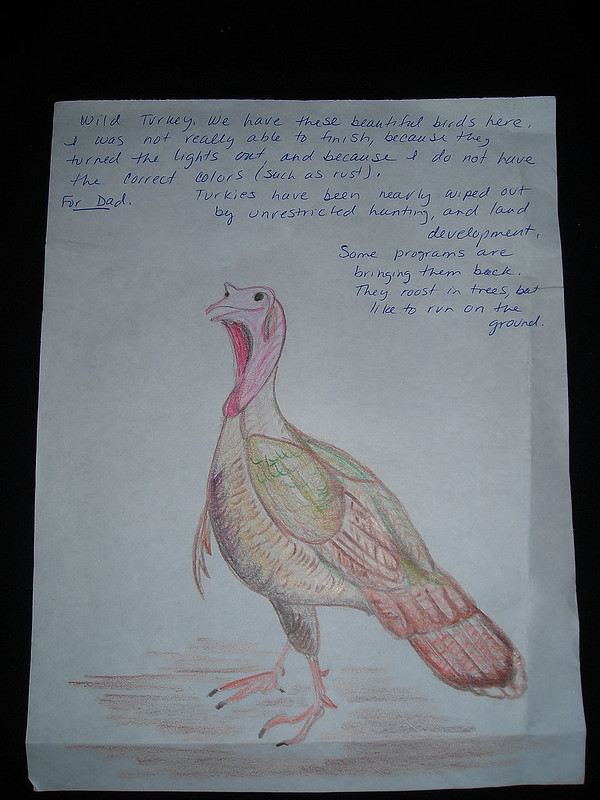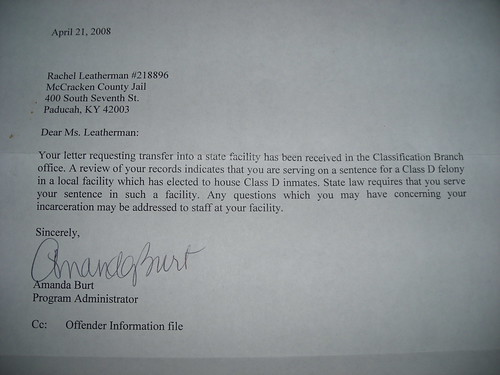Bone with a bow, hand-drawn copy of caricature by Crane-Station on flickr. Prison art, colored pencil and ink.
Frog Gravy is a nonfiction incarceration account.
Frog Gravy contains graphic language.
KCIW PeWee Valley, Winter, 2008-2009.
Wherever you go, there you are, and you just hope that God sets you down someplace and leaves you with a really good story. Kentucky courts bend over backward to help with this.
I love prison. It is helping me to discover who I am and who I am not. I never realized this before, but I really, really enjoy tutoring, particularly in the subject of basic math.
Growing up I had the best of all teaching worlds. My mother is an elderly retired high school Honors English teacher who taught me to write. If there is a better writer in the world than my mother, I would like to see it. Without her, I could not write my way out of a sack. To this day she helps me. My father is an elderly retired chemist and pathologist who ultimately founded a medical laboratory in the Pacific Northwest. He took his training at Emory, and I have yet to meet a more intelligent, methodical and ethical physician of his word. When I was young I often visited him in the basements of hospitals. Ironically, my mother went on later in life to found a center for addicted and incarcerated mothers to obtain treatment and skills needed for transition to a better life, on the outside. The center is in Portland and it is named after her: The Letty Owings Center. Both of my parents are gifted teachers.
I never thought of myself as gifted at anything. But in jail, and particularly in prison, I discover my penchant for teaching.
Tory is a mother of two who never completed the tenth grade. She loves school and wants to sit for her GED. She is enrolled in Algebra and has asked me to help her.
We sit at a table in the crowded, noisy day room of Ridgeview Dormitory, and begin our lessons.
In my mind, however, I am not in prison. I am in a town called Lake Oswego, Oregon, on the deck of my childhood home with my father. He is patiently teaching me math. I learn math in a place that God created called the Willamette Valley, in the shadow of pre-1980 Mount St. Helens, Mount Adams and Mount Hood, and with the Willamette River so close you can hear the water ski boats.
My father demonstrates, in a humorous way, that dividing by zero is not allowed. He starts with allowable math, and then slips in the zero, underneath the dividing line and I fall for it. My father is laughing and I laugh too, because I have been tricked. I will never forget that you cannot divide by zero. I will draw a pastel picture of Mount St. Helens, not knowing its fate.
In prison I try to be my father, but I cannot remember the sequence of equations and letters and lines that he set before me, all those years ago and so, I am a poor imposter.
I say to Tory, “Rest assured. This question will be on a test. Look at the answer choices. If there is ever, anywhere, a zero underneath a dividing line, eliminate the answer choice. Here. Try it on the calculator. Pick any number and divide it by zero.”
Tory punches in some numbers, and the word “error” appears.
“Why is this?” asks Tory.
“It’s just one of those things that is not allowed. You cannot divide something by nothing. You can come close. If you divide something by something small, very close to zero, the number will be very large. But divide by zero and there is no number. There’s not even nothing, because it is just not allowed.”
My explanation is insufficient on its face and I know it. I have insulted my father and I am ashamed.
The lesson continues and I say, “Here is another neat trick. Pick a number. Any number in the world. By the end of this lesson you will be able to multiply and divide any number in the world by ten. You will be able to eliminate some of the answer choices this way. And eliminating multiple choice answers is half the game on a test. The process of elimination will increase the chances that your guess will be right. Are you penalized for guessing on that test? Do you know?”
Tory tells me she will find out.
We continue. I explain how to call an unknown number by the letter ‘x.’ “The object of the game,” I say, “is to get the x onto one side of the equation and get everything else onto the other.”
Turns out Tory is a natural at Algebra. She quickly understands the beginning steps to every problem, no matter how convoluted it looks on paper.
At the end of the lesson, Tory says, “God divided by zero. And he got the universe.”
I begin to wonder if someday, when all of this is behind me, I can return to prison, to teach.
note: Tory was shipped to Otter Creek Prison, just one class shy of sitting for finals and completing her coursework. I received a thank you letter from her while I was still residing at Ridgeview Dormitory. Her spirit was not broken; Even though her schooling had been interrupted and she had to start all over, after she was shipped, she immediately looked for classes to enroll in, at the new location.
Update: Here is what my father taught me all those years ago. I spoke to him yesterday on the phone for Thanksgiving, and he walked me through it. I would like to share it with you here, because of all of the explanations and demonstrations and teaching tricks I have seen and heard, this is the best one.
This is a gem, and if you are teaching algebra to your children or to others, you may want to jot it down.
Let’s start with a simple equation. The quantity on the left is equal to the quantity on the right.
a = b
What we do with one side of the equation, we must do to the other side, so let’s multiply both sides by a:
a squared = ab
Subtract b squared from both sides of the equation:
a squared – b squared = ab-b squared
Now, we can factor this. Here is what that looks like:
(a-b)(a+b) = b(a-b)
Now divide both sides by (a-b):
a+b = b
Okay, now let’s assume that a is equal to b, and substitute:
b+b = b
Well, b plus b is 2b, so:
2b = b
Now, divide each side by b:
2 = 1
But wait! This does not make sense. What is wrong here? It appears mathematically sound, right? Well, our answer tells us that the problem is not mathematically sound, and that there is a fallacy or a false statement somewhere.
The two starting quantities are equivalent, and so a minus b equals zero.
The flaw occurred when we divided by a minus b, or zero. When we did this, it was downhill from there.
One way to teach this is to present the problem like this:
a = b
a squared = ab
a squared – b squared = ab-b squared
(a-b)(a+b) = b(a-b)
a+b = b
b+b = b
2b = b
2 = 1
And simply ask the student what is wrong with the problem.
A round of applause and gigantic hat tip to my father for helping me remember this fun math problem!

















